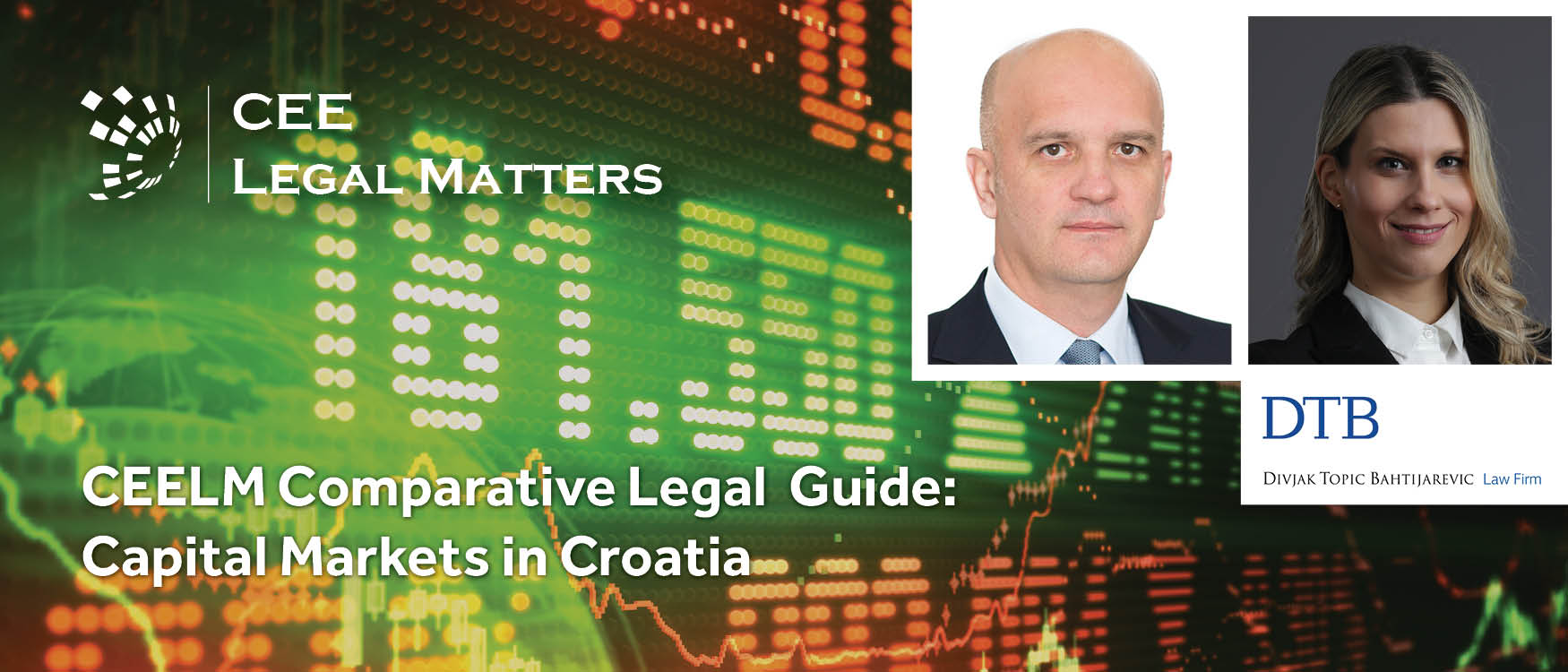Contributed by Karanovic & Partners.
1. Market Overview
1.1. Biggest ECM and DCM transactions over the past 2-3 years
The capital market in Bosnia and Herzegovina (“BH”) is still in the development process and there is still more to do in order to have a reputable capital market. In BH, there are currently two stock exchanges, the Sarajevo Stock Exchange (“SASE”) and the Banjaluka Stock Exchange (“BLSE”), both established in 2001. Prior to that, the BH did not have a market-based economy but its economy was governed by the socialist principles.
In 2019, the SASE recorded a total turnover in approx. amount of EUR 220 million. Through 4,562 transactions, a total of 19,580,404 securities were traded. Using the SASE infrastructure, eight public offers were successfully completed in the 2019, totalling approx. EUR 116 million.
In the same period, BLSE recorded a total turnover in the amount of approx. EUR 240 million. On the BLSE during 2019, the most traded shares on the ECM market were Telekom Srpske shares. On the BLSE, bonds and treasury bills in the primary and secondary markets accounted for 84% of the total turnover. The most traded securities are RS bonds which means that the longstanding trend of shifting investors’ focus from shares to bonds continued.
2. Overview of the local Stock Exchange and listing segments (Regulated and Non-regulated markets)
The capital market in BH is primarily regulated by the FBH Securities Market Law and related by-laws (“FBH Law”) applicable on the FBH territory and by the RS Securities Market Law and the related by-laws (“RS Law”) applicable on the RS territory. The regulator in FBH is the FBH Securities Commission (“FBH Commission”), and in RS the regulator is the RS Securities Commission (“RS Commission”).
2.1. Listing segments (markets)
The Stock Market in FBH is structured as:
1. A Regulated market:
Official Stock Exchange Market (“FBH Market”) which consist of:
- Companies shares market,
- Investment fund shares markets,
- Bonds market, and
- Market for other securities.
Free Market (“FBH Free Market”) which consists of:
- Companies shares market, divided into the following sub-segments:
- Free-market sub-segment 1 (ST1),
- Free market sub-segment 2 (ST2),
- Free-market sub-segment 3 (ST3), and
- Sub-segment for shares of the issuer undergoing bankruptcy proceedings
- Bonds market
- Market for other securities.
2. An Over-the counter (“OTC”) market.
The FBH Market is the place where “blue-chips” are being traded. In order to be listed at this market segment, an issuer has to meet certain requirements, as listed below.
The FBH Free market is the segment of the Stock Market that arranges the connection between the supply and demand aimed at trading with securities that were not listed at the Stock Market. TheST1 sub-segment lists the shares of the 30 most liquid issuers of the Free Market which also have a free-float factor of at least 25% or alternatively, have a free-float market capitalization available for the investors of at least approx. EUR 1 million. These issuers regularly fulfil their reporting obligations. Shares are initially listed on the sub-segment ST2, where they stay until they fulfil the criteria for transfer to another sub-segment. Shares of issuers which fulfil their reporting requirements irregularly or not at all, are transferred to the ST3 sub-segment. Investing in these shares is considered risky, given the fact that no or limited financial information about those issuers exist and that therefore an (accurate) market price cannot be defined. Investors are urged to pay increased attention when trading in those securities. Shares of an issuer are transferred from ST2 to ST3 in case that the issuer ignores a written warning sent to him seven days after the proposed deadline, and after a temporary suspension of trading in his shares as an additional measure. The trading suspension in this case is used to warn possible investors about dangers of investing in these shares.
The return of an issuer from ST3 to ST2 is only possible if all following conditions are met:
- The issuer applied for the pre-segmentation back to ST2,
- The issuer has signed an agreement regarding the publication of his disclosure reports with SASE, and
- The issuer delivers the missing reports for the last three (3) business years.
The Stock Market in RS is structured as:
- Official Stock Exchange Market (“RS Market”) which comprises the following segments:
- Prime Shares Market - List A,
- Standard Shares Market - List B,
- Starting Shares Market – List C,
- Closed Investment Funds,
- Open Investment Funds,
- Bonds and other debt securities,
- EU Connect Market, and , and
- other securities.
- The Free Market (“RS Free Market”) comprises the following segments:
- Shares,
- Closed Investment Funds,
- Open Investment Funds,
- Bonds,
- Share Packages,
- Shares of Issuers in Delay with Financial Reporting;
- Shares of Issuers undergoing Bankruptcy or Liquidation Procedure, and
- other securities.
The RS Market is established to perform activities on connecting supply and demand in securities trade; to determine and publish information on demand, supply, price lists and any other data on securities, i.e. for organized, transparent, liquid and efficient trading in securities and provision of relevant information, in compliance with the law and other regulations.
The RS Free Market means an organized securities market where the securities not listed on the RS Market are being traded.
The RS Market is an important part of the market where, in addition to the general conditions, it is necessary to meet specific criteria related to the size of capital, ownership dispersion, business performance and objectivity of financial reporting. Considering the current situation regarding the capital market in RS, the RS Free Market is emerging as the segment that comprises most of the securities that arise in privatization processes since the issuer has to fulfil only the general conditions related to securities in order to be issue securities on the RS Free Market. The RS Free Market also consist of the securities which are excluded from the RS market in cases where such securities are not withdraw completely.
3. Key Listing Requirements
3.1. FBH
In accordance with the Rules of SASE an unlimited number of transferable securities which are fully paid, and which meet the following criteria can be listed on the FBH Market:
3.1.1. for shares:
- the issuer is a joint stock company established and operating in accordance with the regulations of the FBH,
- the sum of the share capital and the capital reserves of the issuer including the profit or loss in the previous fiscal year amounts to a minimum of approx. EUR 22 million,
- Financial reports of the issuer have to be audited and available for minimum of 3 years,
- at least 25% of the share class that stands as the subject of the listing request needs to be issued by a public offer, unless the market is operating satisfactorily with a lower percentage, in which case the approval of the Commission is required,
- minimum share class size (considered to be the book-keeping value of share if the securities are not listed in organized trading, otherwise market capitalization) in the amount of approx. EUR 1 million, and
- share class owners - at least 150.
3.1.2. for bonds:
- the issuer is a joint stock company established and operating in accordance with the regulations of the FBH;
- the sum of the share capital and the capital reserves of the issuer, including the profit or loss in the previous fiscal year amounts to a minimum of EUR 2 million,
- Financial reports of the issuer have to be audited and available for minimum of 3 years, and
- the minimum nominal value of the bond series must be approx. EUR 1,5 million.
3.1.3. for other securities:
- the issuer is a joint stock company established and operating in accordance with the regulations of the FBH;
- the sum of the capital stock and the capital reserves of the issuer including the profit or loss in the previous fiscal year amounts to minimum of approx. EUR 2 million, and
- Financial reports of the issuer have to be audited and available for minimum of 3 years.
A security can be listed on the FBH Market even if it does not meet the criteria of the minimum value of class / series of securities or the number of owners of securities if those differences are not important or if there is a reasonable expectation that these requirements will be met shortly upon listing.
The FBH Commission can approve the listing of securities of a newly established company incorporated by merger, in which case it will be considered that all requirements have been duly met, regardless of the fact that the securities of at least one merged or one divided company were listed on the FBH Market prior to the restructuring procedure.
3.2. RS
In order to be listed on the RS Market, the securities must fulfil the general following conditions:
- that they are fully paid in,
- that they are freely transferable,
- that they are issued in non-materialized form.
3.2.1 for shares
The shares will be listed on the List A of the RS Market if the issuer (in addition to the above listed general conditions), fulfils the following special criteria:
- Three years of operation,
- shares book value, or market capitalization if the shares have already been listed in the organized market, is at least EUR 20 million for ordinary shares and EUR 2.5 million for preference shares
- the free float is at least 15% or EUR 5 million,
- the minimum number of shareholders is 300,
- issuer has adopted a own written code of conduct or accepted the standards of corporate governance passed by the RS Commission,
- issuer has an Internet pages where the information on an issuer is available in English language as well,
- audited annual financial statements have been prepared in accordance with law – with unqualified or qualified auditor’s opinion,
- shares have been traded at least on 30% of trading days for the last six months with average daily turnover of at least EUR 2,500,
- issuer has not continually reported losses for the last three business years according to audited financial statements.
When determining the percentage of the shares in public ownership, the following securities shall not be considered:
- shares owned by the Management Board of the issuer,
- shares owned by those shareholders holding more than 10% of shares.
When determining the percentage of shares in public ownership, the shares owned by investment funds will not deducted. Shares may be listed on the List A, even if it fails to comply with one of the special conditions, provided such failure is not deemed as a material discrepancy or if there are reasonable expectations that such a requirement will be met shortly after the security has been listed.
The RS Commission may also list on the List A of the RS Market, the securities of a new joint stock company that has been established by a merger of two or more companies, or by the division of an existing company if the shares of any of those companies have already been listed on the official Stock Exchange market.
In order to be included on the List B of the RS market, the following conditions must be fulfilled:
- Two years of operation,
- Audited financial statements,
- shares book value, or market capitalization if the shares have already been listed in the organized market, is at least EUR 5 million for ordinary shares and EUR 500,000.00 for preference shares,
- the free float is at least 10% or EUR 500,000.00
- The minimum percentage of the stock in public ownership is 15%,
- the minimum number of shareholders is 200.
- issuer has adopted a own written code of conduct or accepted the standards of corporate governance passed by the RS Commission
On the List C shares of issuers that do not fulfil or ceased to fulfil listing criteria for the List A or List B shall be listed. In order to be included on the List C of the RS market, the following conditions must be fulfilled:
- two years of operation,
- audited annual financial statements have been prepared in accordance with law – with unqualified or qualified auditor’s opinion,
- shares book value, or market capitalization if the shares have already been listed in the organized market, is at least EUR 500,000.00,
- the free float is at least 10% or EUR 250,000,
- the minimum number of shareholders is 10,
- issuer has adopted own written code of conduct or accepted the standards of corporate governance passed by the RS Commission.
On the Market for Securities of the issuers from the EU shares, bonds and depository receipts shall be listed. Special criteria for the listing on EU Connect Market are:
- that issuer has already listed shares on the Stock Exchange from the EU or that the issuer is a subsidiary of the company that has already listed shares on the Stock Exchange from the EU,
- that the issuer is seated in EU country,
- that the value of listing is at least EUR 500.000,
- that issuer has audited annual financial statements with unqualified or qualified auditor’s opinion,
- that issuer has at least 10 shareholders,
- that issuer has the prospectus which is approved by the RS Commission and
- to have written agreement with the listing sponsor while it is listed on the Stock Exchange.
3.2.2. Bonds and other securities
Bonds and other long- and short-term debt securities can be listed on the RS Market, if in addition to general criteria, the insurer have to fulfil the following special criteria’:
- Two years of operation;
- Audited financial statements;
- The total nominal value of the listing amounts to EUR 500,000.
4. Prospectus Disclosure
4.1. Regulatory regimes (Prospectus Regulation or similar) – equity and debt
The prospectus is governed by the FBH and the RS Securities Law and related by-laws. The publication of the prospectus is a mandatory step in the process of issuing securities by public offering.
4.2. Local market practice
4.2.1. FBH
Issuer in the sense of FBH Law is a legal entity that, by virtue of the law, may issue securities for the purpose of raising funds and which, has obligations specified in the security towards the owners.
The issuer is obliged to prepare a prospectus which should contain enough information for the investor to evaluate the status of the assets, liabilities, losses and profits, financial position of the issuer, and the rights contained in the securities to which the prospectus relates. The prospectus must be approved by the FBH Commission.
The prospectus used in the public offering of shares must contain information on:
- the issuer;
- the securities that are the subject of the issue (indication of the type, class, number of and the total number and rights they contain),
- the price or method of determining the price of the securities, and a description of the manner in which the securities are distributed,
- the place, manner, term and time of registration and payment,
- the agent and the sponsor, if the emission is performed with the mediation, and the guarantor if the issuance is guaranteed,
- investment risk and risk causes,
- pre-emptive rights and the proxies, if applicable,
- restrictions on purchases, the scope of the restrictions and the persons concerned, if applicable;
- the activities and business operations of the issuer,
- authorized representative of the issuer,
- a signed statement of the issuer’s authorized representative;
- the depositary bank of the issuer, and
- investment statement.
The prospectus for the issuance of debt securities must also contain statements on the calculation of interest, payment of interest, delay with payment of interest, consequences in case of delay with payment of principal and interest and possible early redemption of debt securities.
In case the bonds that are being issued give the right to exchange for other securities (conversion) this must be stated in the prospectus as well.
In the closed issuance of shares, the issuer prepares the abbreviated prospectus. The FBH Commission approves the listing on the basis of the submitted application and the abbreviated prospectus and other documentation but does not give an opinion on the proposed investment, nor is it responsible for the completeness and accuracy of the information contained in the abbreviated prospectus.
4.2.2. RS
When issuing new securities in RS with public offer the issuer is obliged to prepare and publish the prospectus. In case of a public offer, the issuer may publish the preliminary prospectus with the aim to feel the interest of the investors.
The prospectus and the preliminary prospectus must contain complete, accurate and objective information about the assets and liabilities, financial position, purpose of raising funds, risk factors, and rights the securities provide on the basis of which the potential investor can objectively assess the investment risks and make an investment decision. The preliminary prospectus and prospectus shall be published upon approval by the RS Commission.
The accuracy and completeness of the information published in the preliminary prospectus are the responsibility of the issuer, the authorized persons of the issuer and the auditor.
The prospectus must contain the following:
- information on the issuer,
- information on the securities that are the subject of the issue,
- information about the issuer’s business operations,
- information on the place, manner, term and time of subscription and payment of securities,
- a statement on investment,
- information on the authorized representatives of the issuer,
- information on the issuance guarantor,
- statement of the authorized representatives of the issuer, and
- the data and signature of the agent of issuance, if engaged.
The preliminary prospectus contains all above mentioned information, except for information on the place, method, term and time of subscription and payment of securities.
4.3. Language of the prospectus for local and international offerings
Local Stock Exchange regulations do not differentiate between domestic and international securities offerings in terms of language. The prospectus should be submitted in one of the official languages of BH (Bosnian/Serbian/Croatian), as well as in English if the issuer has more than 100 shareholders - applicable in FBH, while in RS the prospectus will be delivered in English only if it relates to List A and investment funds.
5. Prospectus Approval Process
5.1. Competent Regulator
5.1.1. FBH Commission
Functioning under a number of local pieces of legislation, the mission of the FBH Commission is: (i) to support the establishment and the development of the capital market; (ii) to regulate, maintain and promote a fair, secure and transparent capital market; (iii) to protect and promote investor protection; to build trust in the efficiency and fairness of the local capital market.
Based on the provisions of the local legislation there is a basic division of jurisdiction between the FBH Commission and the SASE. The FBH Commission may freely inspect books, letters and other documents of brokerage firms and banks, referring to dealing in securities. It may also authorise the SASE or another legal person to carry out individual tasks related to monitoring.
The monitoring of SASE focuses mainly on detection of members’ malpractices such as insider trading, price manipulation, dishonest applications and cancellations of trades, front running, and on finding acts contrary to good business practice.
5.1.2. RS Commission
Established under the local securities legislation, the RS Commission is the financial services regulator. It is a permanent and independent legal entity, which through regulation, promotion and monitoring shall attempt to achieve its primary objectives of: supporting the establishment and the development of the capital market; the efficient functioning of a regulated, fair, open securities market in order to gain the confidence of all market participants; protection of investor and other market participants’ interests. Timeline, number of draft submissions, review and approval process
5.2. Timeline, number of draft submissions, review and approval process
The procedure of approval of the prospectus is performed within the procedure of approval of the request for emission of securities (“Request”). The Request must be submitted within 90 days as of the date of issuance of the decision on emission to the FBH Securitas Commission. The Request must be submitted 60 days before the date determined by the issuer as the date for registration of the securities. Together with the Request the following documentation must be delivered:
- the decision on emission;
- the Articles of Association;
- excerpt from the court registry of companies;
- an agreement between the issuer and the depositary bank;
- agreement between the issuer and the registry of issuers;
- financial and audit reports in accordance;
- the proposal of the prospectus;
- proof of payment of the fee;
- the opinion or consent of the body competent to supervise the operations of financial organizations, if the issuer is a financial organization;
- other documents as requested by the FBH Commission.
The FBH Commission must decide on the Request within 60 days as of the date of the receipt of the Request. With the decision on approval of the Request, the FBH Commission confirms that the issuer acted in accordance with the law and other regulations and that the prospectus contains all necessary elements.
RS
The request for approval of the prospectus is submitted by the issuer or stockbroker on behalf and for the account of the issuer. Together with the prospectus, the issuer must submit:
- the proposal of the prospectus;
- the decision of the competent authority to include a particular security in the trading system on the RS Market;
- the Memorandum of Association;
- excerpt from the court registry of companies,
- annual financial statements (individual and consolidated if prepared) for the preceding two years and the corresponding reports of the certified auditor, and the last periodic statement if the prospectus approval application is submitted after 31 July of the current year,
- the financial statement and the corresponding report of the certified auditor for a period shorter than the period specified in previous item, if the issuer operates for a shorter period,
- the relevant document of the RS Commission on the assignment of an ISIN and CFI number,
- proof of payment of the fee.
In case that the issuer requests approval of the unique prospectus, both for the issuance of the securities and for listing of the securities to the RS market, the following documentation must be submitted, together with the prospectus proposal:
- the decision on issuance of the securities,
- the minutes of the meeting of the competent body at which the decision on the issue was made, with the list of members present, and if the decision on the issue was made by the shareholders assembly, the minutes should contain the list of present and represented shareholders, as well as the individual number of votes used in determining the quorum for the work,
- the decision of the competent authority to include a particular security in the trading system on the RS Market,
- Memorandum of Association,
- excerpt from the court registry of companies,
- the agreement between the issuer and the bank on the opening of a temporary account for the deposit of payments based on the purchase of the issued securities;
- annual financial statements (individual and consolidated if prepared) for the preceding two years and the corresponding reports of the certified auditor, and the last periodic statement if the prospectus approval application is submitted after 31 July of the current year;
- the financial statement and the corresponding report of the certified auditor for a period shorter than the period specified in previous item, if the issuer operates for a shorter period,
- confirmation of the authorized bank for payment operations on the balance of the issuer’s business accounts for the last 60 days until the day of application (liquidity certificate);
- the agreement concluded between the issuer and the stockbroker for the purpose of sale of the issued securities on the RS Market,
- the agreement concluded between the issuer and the agent, the transferee or the guarantor of the issuer, if such agreement is concluded,
- the relevant document of the RS Commission on the assignment of an ISIN and CFI, and
- proof of payment of the fee.
If the issuer is a bank or other financial organization, the written approval of the competent regulatory authority for the issuance in question shall be also delivered.
The foreign issuer, when requesting the approval of the prospectus, besides the above listed documents, must deliver the written confirmation from the its country’s competent authority that the securities for which the request is submitted are the same class as the securities offered in the issuer’s home country, based on the approved prospectus, that is, traded on the regulated market in the home country.
6. Listing Process
a. Timeline, process with the stock exchange
FBH
The procedure for issuance of the securities in the FBH Market is initiated based on the request by the issuer or by the authorized person together with the following documents:
- copy of the decision on registration of the issuer at the FBH Commission,
- Article of Association,
- copy of audit reports for the last three business years,
- the proof of registration of securities,
- list of the top ten security owners and their shares,
- list of securities in the ownership of the issuer’s Managements board,
- the prospectus,
- evidence on payment of fee.
Upon the submission of the request, the FBH Commission must review whether all assumptions for the decision-making on the request are completed within seven days:
- if the request was submitted by an authorized individual,
- if the request template comprises prescribed information,
- if attachments listed above are attached to the request template.
It the request is complete, the FBH Commission within 15 days initiates the procedure for detailed examination of the request. The decision on the approval or rejection of issuance of securities is delivered to the applicant within five days after the decision. The decision should contain an introduction, the enacting terms, explanation and legal remedy.
The Rules of BLSE stipulate the following:
The procedure for listing on the BLSE shall start upon a request by the issuer or a person authorized by the issuer. The application form shall be accompanied by:
- document of registration securities in the registry of RS Commission,
- prospectus in electronic form,
- Articles of Association in electronic form,
- excerpt from the court register certified by the issuer,
- audited financial statements in electronic form,
- report of the percentage of securities held by the management and supervisory body of the issuer,
- a list of authorized people for communication with the Exchange,
- fee payment evidence,
- written code of conduct or decision to accept the standards of corporate governance passed by the RS Commission.
The RS Commission shall decide on the listing on the Stock Exchange within 30 days after the application is submitted. The RS Commission may reject application for listing if:
- the issuer does not fulfil listing requirements,
- the issuer has not submitted the required documentation,
- there are circumstances that could threaten the interests of investors.
When the RS Commission determines that the requirements for listing have been fulfilled, it shall decide to list the securities to the Stock Exchange.
7. Corporate Governance
7.1. Corporate governance code / rules (INED, board and supervisory composition, committees)
7.1.1. FBH:
The FBH Company Law, which governs the corporate governance, stipulates that joint stock company organizes its work through the following corporate bodies:
- General Assembly,
- Management, and
- Supervisory Board.
According to the FBH Company Law, the Management of a joint stock company organizes the work and manages the business, represents the company and is responsible for the legality of the business. The Management of a joint stock company consists of a director or a director and one or more executive directors. The procedure for election, appointment, dismissal, composition and decision-making of the Management shall be determined by the company’s Articles of Association.
The director acts as a chairman of the Management, manages the business, represents the joint stock company and is responsible for the legality of the business. The Management is appointed for the period of four years. The rights and obligations between the members of the management board and the company are regulated by a special agreement.
Since they fall into the category of persons with special duties towards a joint stock company, the director and the executive directors are obliged to report to the Supervisory Board any direct or indirect interest in the legal entity with which the joint stock company has or intends to enter into business relations. In the event that the director resigns, he / she shall continue to perform his / her duties within the notice period set by the Supervisory Board, and which may not be less than 30 days.
The Supervisory Board consists of the president and at least two members appointed and dismissed by the Company’ Assembly, whereby the total number of Supervisory Board members must be odd. The members of the Supervisory Board are appointed at the same time for a period of four years, but after the expiration of a period of two years from the date of appointment, the Company Assembly votes on confidence of the Supervisory Board.
The Supervisory Board is in charge for supervision of the business of the joint stock company, supervises the Management Board, appoints the Management Board and the Secretary of the company, submits the annual report to the Company Assembly etc.
Of course, a person who has been convicted of a criminal offense and an offense incompatible with the duty of the duty of Supervisory Board member, may not be appointed, five years from the date of the final verdict, excluding the time of imprisonment, nor by a person who is prohibited by the court’s judgment from performing activities as a Supervisory Board member.
The joint stock company has the Secretary appointed by the Supervisory Board. The Secretary is responsible for keeping the minutes of the Company Assembly and the documents determined by the FBH Company Law and the Articles of Association. The Secretary is also authorized to implement the decision of the Company Assembly, Supervisory Board and the Management Board.
Additionally, the Audit Committee is formed in the joint stock company with at least three members. The Audit Committee is obliged to audit the semi-annual and annual accounts and at the same time to control the compliance of the Company’s business operations and the functioning of the Company’s bodies in line with the FBH Company Law, other relevant regulations and basic principles of corporate governance, and to report to the Assembly and the Supervisory Board at the latest eight days after the completion of the audit.
7.1.2. RS:
RS Company Law stipulates that open joint stock company organizes its work through the following corporate bodies:
- General Assembly;
- Management Board, and
- Supervisory Board.
The number of members Management Board of an open joint stock company is determined by the Memorandum of Association. The Management Board has at least three members and a maximum of 15 members. These members are appointed for a maximum term of five years with the possibility of re-election, but their engagement may be terminated at each annual meeting of General Assembly if the annual business report is not adopted.
Open joint stock companies whose shares are listed on the official stock market must have a majority of non-executive members of the Management Board, of which at least two are independent members.
An independent member of Management Board is a person who, alone or with family members, in the two previous years:
- was not employed by the company,
- did not paid to the company or received from the company payments of more than EUR 10,0001,
- does not own more than 10% of the shares or interests, directly or indirectly, in the entity who paid or received from the company an amount greater than EUR 10,000,
- does not directly or indirectly (including other related parties within the meaning of this Law) own the shares of the company representing more than 10% of the share capital of the company,
- was not a director of the company or a member of the Management Board, unless he / she was an independent member and,
- was not an independent auditor of the company.
The chairman of the Management Board is elected by the members, i.e. by a majority of the total number, unless a Memorandum of Association or Articles of Association specifies a different majority.
The company may have one or more executive directors which act as representatives of the company. In case there are more than one executive directors, the Management Board appoints one executive director as General Director and the Executive Board is being formed. The General Director represents the company. The General Director of a joint stock company convenes and chairs the Executive Board, organizes its work and takes care of keeping minutes of those sessions.
8. Documentation and Other Process Matters
8.1. Over-allotment (greenshoe or brownshoe structure)
The respective laws contain limited provisions on underwriting - it recognizes the underwriter as an investment company which provides underwriting services in relation to placing of financial instruments on the firm commitment basis.
While over-allotment is not clearly regulated under BH laws, it could be deemed as possible and available, since there is no explicit ban with that respect.
8.2. Stabilisation – whether allowed and on what terms (MAR, local regimes)
Stabilisation is not defined by the respective BH laws as they do not contain adequate provisions related to the stabilisation. However, stabilisation is listed as a section of a prospectus but there are no additional definitions and terms of the stabilisation in that respect.
9. Ongoing Reporting Obligations (Life as a Public Company)
9.1. Annual and interim financials
In accordance with FBH Law, the issuer is obliged to submit to the SASE the following reports by the 30 April of the current year for the previous year:
- a semi-annual and annual reports on its business operations,
- reports on events that significantly affect financial business of the issuer,
- prospect of any new security issued,
- reports on the results of each new public offer of securities.
In cases when the accounting standards or other regulation requests drafting of consolidated accounting reports the following information must be included in the annual report:
- The name of companies included in the consolidation;
- Auditor opinion on consolidation accounting report,
- Consolidated Balance Sheet, Consolidated Income Statement and Consolidated Statement of Cash Flows on the same items as those indicated in the Audit Report or Prospectus, respectively, for the business year to which the annual report relates and for the previous financial year.
The semi-annual and annual report must contain the following information on:
- members of the Supervisory Board and the Management Board and the number of shares they own;
- shareholders holding more than 5% of the voting shares;
- legal entities in which the issuer holds more than 10% of the shares;
- representative offices of the issuer;
- the Shareholders meeting held during the reporting period;
- balance sheet and income statement at the end of the period;
- the use of capital acquired through the previous issue of securities through a public offering;
- decrease or increase of the issuer’s assets by more than 10% compared to the situation in the previous report, with the facts that influenced it;
- reduction or increase of the incompetence or loss of the issuer by more than 10% compared to the situation in the previous report, with the facts that affected on it;
- transactions in assets exceeding 10% of the value of the total assets of the issuer at the date of the transaction;
- the issue of securities performed during the reporting period indicating the type and class of securities; and
- Issuers whose securities are listed are obliged to submit to the SASE quarterly financial reports on their operations within 30 days after the end of the accounting period. The complete report of the external auditor on the performed audit of the annual report on the Issuer’s business operations shall be submitted electronically by the date of the general meeting of the issuer at which the report will be considered, and not later than six months after the end of the business year.
The events that significantly affect financial business of the issuer are:
- reorganization of the issuer and related parties;
- the decision to issue and any initiated, suspended or terminated issue of the securities;
- the acquisition of more than 5% of the voting shares of a single shareholder;
- payment of financial liabilities to shareholders;
- the decision to convene a Shareholders meeting;
- change of auditor;
- a one-time increase or decrease of the issuer’s assets by more than 10%; and
- a one-time transaction in the amount exceeding 10% of the value of the total assets of the issuer.
The RS Law provides an obligation to the issuer to submit the following reports:
- a semi-annual and annual reports;
- reports on events that significantly affect financial business of the issuer;
- the audit report if applicable;
Furthermore, in case an issuer fulfils the following conditions: a) issues shares by public offering, b) has more than 100 shareholders, c) has a share capital of at least EUR 5 million, and d) has a total annual income of at least EUR 5 million, additional following reports are to be submitted:
- quarterly financial statements within 30 days of the last day of the quarter,
- annual financial and business reports, including consolidated financial statements within 60 days after the end of the business year,
- the audit report within 5 days from the date of receipt of that report.
Additionally, the events that affect the financial business year of the issuer in RS are:
- the decision to convene a shareholders meeting,
- change of name or reorganization of the issuer,
- proposals for decisions regarding status changes merger and division), and a change in the principal activity of the issuer,
- establishment of a subsidiary or joint venture in which the issuer would participate with more than 10% of the total value of its fixed assets,
- sale, transfer or pledge of fixed assets in excess of 10% of the total fixed value of the property,
- borrowing that exceeds 10% of the total assets of the issuer,
- conclusion of agreements that could possibly lead to the increase in the value of revenue or expense in excess of 10% of the value of revenue or expenses of the issuer in the current accounting period,
- initiation of liquidation or bankruptcy proceedings,
- proceedings before the courts and other state bodies, with an assessment of the outcome of the proceedings,
- obtaining or losing a concession, patent, license or similar right,
- business events that result in a decrease or increase in total assets as a percentage greater than 10% of its value,
- the decision to issue securities, except in the case of a public offering,
- the decision to acquire its own shares,
- resignation or dismissal of members of the Management Board, Supervisory Board and auditors,
- the final judgment of the court against members of the Management Board and the Supervisory Board,
- development plans and their impact on the economic and social position of employees,
- related party transactions,
- measures to improve working conditions and changes in employee earnings,
- the decision to allocate retained earnings and
- other decisions of the issuer’s shareholders assembly, and other events that may have a significant impact on the value of the securities of the issuer.
9.2. Ad hoc disclosures
9.2.1. FBH
The issuer shall, as soon as possible but no later than eight days after the occurrence of the event, inform the SASE on the event which significantly affects the financial operations of the issuer. Additionally, the issuer must submit the following information:
1. Data on business and other events, changed business conditions and events from the environment which might influence the legal and financial position of the company and issued securities’ price with the emphasis on:
- business interruptions,
- relevant changes in the main business activity,
- intended relevant changes in the company’s accounting policy,
- changes in the Management Board,
- relevant legal procedures before the state institutions, arbitrage and similar institutions,
- significant changes on the market,
- previous company’s business result perspectives, as well as possible relevant perspective alterations,
- gained or lost patents, licences, brands of importance which are of the high importance for the main activity,
- new products, i.e. services or parties which influence the business activity and the derived business results.
2. Decisions and resolutions, as well as other events which might influence the capital structure, such as:
- intended increase or reduction of share capital,
- changes in the content of the class right of securities admitted to the Stock Exchange listing and securities in which securities admitted to the Stock Exchange are replaceable,
- pre-emptive right at the new issue of securities
- conducted purchase or sale of the issuer’s own shares,
- revocation of debt securities admitted to the Stock Exchange listing, before they are due,
- inability to fulfil the obligations due to the issued debt securities
- inability to pay dividends.
3. Projected data changes with the issuer and the amendment of the issuer’s legal and organizational structure which might influence the issued securities’ price, such as:
- acquisition of the issuer to the other company or vice versa,
- merging with another company,
- change of legal form,
- other changed circumstances and events which cause the change of data stated in the leaflet for admission of securities to the listing, considering the issuer’s later announcements.
4. Other events and circumstances not well known which might have significant influence on the issued securities’ price.
9.2.2. RS
The issuer is required to disclose to BLSE the following events:
1. changes in financial and legal position,
2. changes of issuer’s equity,
3. convening general shareholders meetings,
4. decisions of general shareholders meetings,
5. Management and Supervisory Boards’ decisions,
6. changes in the status of issuers,
7. acquisition of significant ownership in other entities,
8. acquisition of securities by the issuer’s management,
9. press conferences,
10. other events that may affect the price of securities or upon the request of the Exchange.























